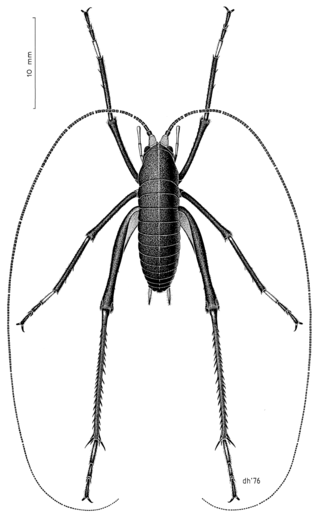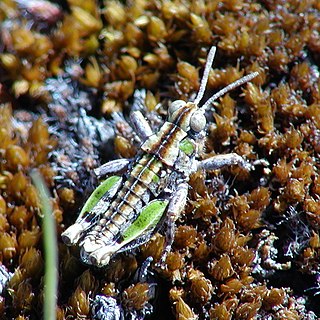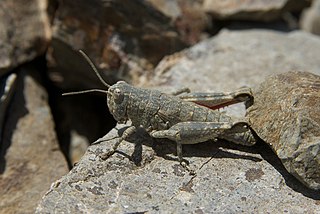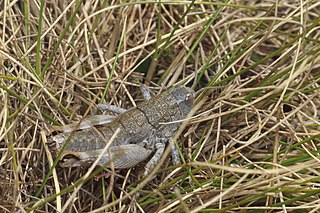
Tree wētā are wētā in the genus Hemideina of the family Anostostomatidae. The genus is endemic to New Zealand. There are seven species within the genus Hemideina, found throughout the country except lowland Otago and Southland. Because many tree wētā species are common and widespread they have been used extensively in studies of ecology and evolution.

Hemiandrus is a genus of wētā in the family Anostostomatidae. In New Zealand they are known as ground wētā due to their burrowing lifestyle. Hemiandrus wētā are nocturnal, and reside in these burrows during the day. Ground wētā seal the entrance of their burrow during the day with a soil plug or door so that their burrow is concealed. This genus was originally said to be distributed in Australia and New Zealand, however, with recent molecular genetic methods, this is under debate. Ground wētā adults are smaller than other types of wētā, with the unusual trait of having both long and short ovipositors, depending on the species. The name of this genus is said to come from this trait as hemi- mean half and -andrus means male, as the species where the female has a short ovipositor can sometimes be mistaken for a male. This genus has a diverse diet, depending on the species.
Insulanoplectron is a genus of cave wētā in the family Rhaphidophoridae, with just one species: the Snares Island Wētā. Insulanoplectron spinosum is endemic to the subantartic Snares Island of New Zealand, where it is considered to be naturally uncommon. Wētā are nocturnal crickets found all around the world. During the day on the Snares, wētā can be found hiding in seabird burrows.

Novoplectron is a monotypic genus of cave wētā in the family Rhaphidophoridae, endemic to the Chatham Islands. Cave wētā are nocturnal, wingless crickets that occupy humid habitats. Novoplectron wētā generally live under stones and in burrows of seabirds, such as broad-billed prions, mutton birds and storm petrels.

Pharmacus is a genus of cave wētā in the family Rhaphidophoridae, endemic to New Zealand. All species are alpine adapted and found at high elevations in the South Island. They live among rocks on high mountain ridges, often well above glaciers and vegetation. Pharmacus has a geographical range that extends from Nelson south to central Otago and Fiordland. They are small insects with a body length of approximately 14-20mm. In this genus, females are larger than males. All species exhibit dark brown to black pigmentation of the body and legs. They have a dense clothing of setae and a serrated ovipositor. When active they are lively jumpers. For example, Pharmacus montanus is known as the Mount Cook flea because of its habit of leaping out of rock crevices on to mountain climbers.

Pleioplectron is a genus of cave wētā in the family Rhaphidophoridae, endemic to New Zealand. These wētā are fairly common at night among the leaf litter in native forest in the South Island of New Zealand. The species look very similar to species of Miotopus, another New Zealand endemic genus, recently resurrected.

Sigaus childi is an endangered protected species of grasshopper known only from the Alexandra district of the South Island of New Zealand. It is one of just two species of grasshopper listed for protection under the New Zealand Wildlife Act 1953. It is currently classified as "At Risk, Naturally Uncommon" by the Department of Conservation. The genus Sigaus is endemic to New Zealand.

Brachaspis robustus is a nationally endangered species of grasshopper endemic to the Mackenzie Basin of the South Island of New Zealand. The genus Brachaspis is endemic to the South Island of New Zealand. Although a grasshopper, it is a poor jumper, relying on camouflage to hide from predators. It is threatened by introduced mammals such as stoats, hedgehogs, and rats.

Alpinacris tumidicauda is a species of grasshopper only known from Otago and Southland, New Zealand. The genus Alpinacris is endemic to the South Island of New Zealand. A. tumidicauda was described in 1967 by Robert Sidney Bigelow, with a type locality of Obelisk in the Old Man Range (45°19′22″S169°12′27″E). A male holotype and paratype are deposited in the Canterbury Museum, Christchurch. Like all of New Zealand sub-alpine and alpine grasshoppers, A. tumidicauda has a 2- or 3-year life cycle. The eggs must "overwinter" before they will hatch. Hoppers are found throughout the year, and adult grasshoppers can be found throughout the New Zealand summer between December and April. The adult A. tumidicauda do not overwinter.

Deinacrida connectens, often referred to as the alpine scree wētā, is one of New Zealand's largest alpine invertebrates and is a member of the Anostostomatidae family. Deinacrida connectens is a flightless nocturnal insect that lives under rocks at high elevation. Mountain populations vary in colour. This species is the most widespread of the eleven species of giant wētā (Deinacrida).

Sigaus is a genus of grasshoppers in the tribe Catantopini that is endemic to New Zealand. All but one Sigaus species is endemic to the South Island: Sigaus piliferus is the only North Island representative and is the type species. Most species in this genus are restricted to alpine habitats. All are wingless and make no sounds.

Sigaus australis is the most common alpine grasshopper found in New Zealand. It can be found in the southern half of the South Island above the tree line. Sigaus australis was described in 1897 by Frederick Hutton. Like all of New Zealand sub-alpine and alpine grasshoppers S. australis has a 2 or 3 years life cycle. Individuals can survive the cold by freezing solid at any life stage, at any time of the year. Sigaus australis adults are relatively large grasshoppers. The genus Sigaus is endemic to New Zealand.

Phaulacridium marginale is a small species of short-horned grasshopper in the family Acrididae. It is endemic to New Zealand where it is found in low elevation open habitat throughout North Island, South Island, Stewart Island and on many smaller islands.

Phaulacridium otagoense is an endemic New Zealand grasshopper found at low elevation throughout the central South Island.

Phaulacridium is a genus of grasshoppers in the tribe Catantopini from Australia and New Zealand. These short-horned grasshoppers have a single generation each year

Sigaus minutus is a species of short-horned grasshopper in the family Acrididae. It is one of the smallest and rarest species of grasshopper in New Zealand, found only in the Mackenzie district of South Island. There are nine species within the genus Sigaus described by Bigelow (1967), all endemic to New Zealand. The population status of Sigaus minutus is declining according to threat assessments made by orthopteran experts in 2010.

Brachaspis nivalis, is an alpine short-horned grasshopper, endemic to the South Island of New Zealand. Brachaspis nivalis is brachypterous and flightless, therefore they travel by hopping. They bask during the day so need open habitat.

Wētā is the common name for a group of about 100 insect species in the families Anostostomatidae and Rhaphidophoridae endemic to New Zealand. They are giant flightless crickets, and some are among the heaviest insects in the world. Generally nocturnal, most small species are carnivores and scavengers while the larger species are herbivorous. Although some endemic birds likely prey on them, wētā are disproportionately preyed upon by introduced mammals, and some species are now critically endangered.

Hemiandrus focalis is a species of ground wētā endemic to New Zealand. This flightless Orthoptera lives in the mountains of the South Island, New Zealand. This species can be distinguished from other ground wētā by their three superior retrolateral spines on their mid tibia and females have relatively long ovipositors. This omnivorous ground wētā species is listed as "not threatened" by the New Zealand Department of Conservation.

The Green Rock-hopper grasshopper, Brachaspis collinus is an alpine species of short-horned grasshopper in the family Acrididae. It is found in New Zealand in the mountains of northern South Island, above the tree line and as high as 2000 m asl. In New Zealand alpine grasshoppers can freeze solid at any time of the year and are alive when they thaw out when temperatures rise.


















